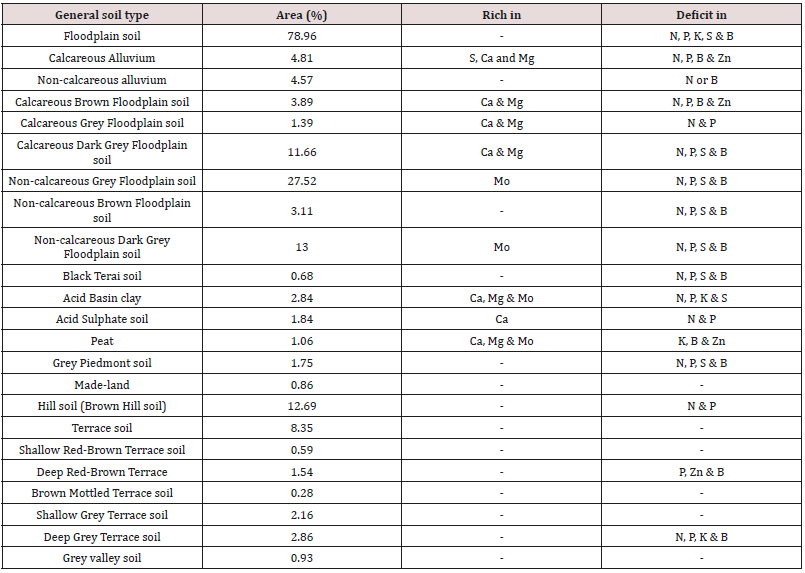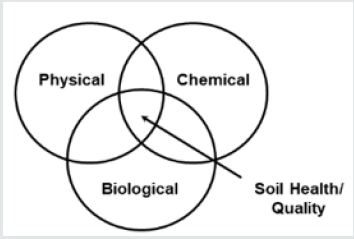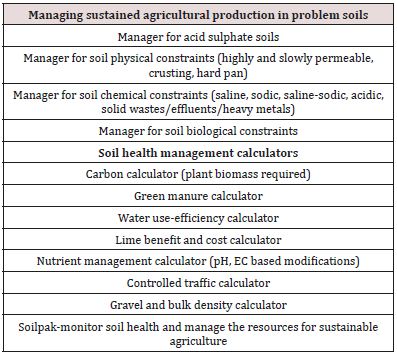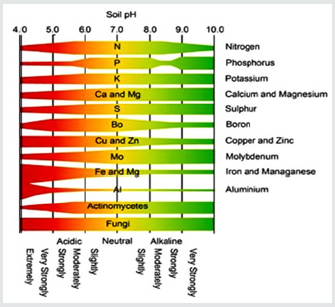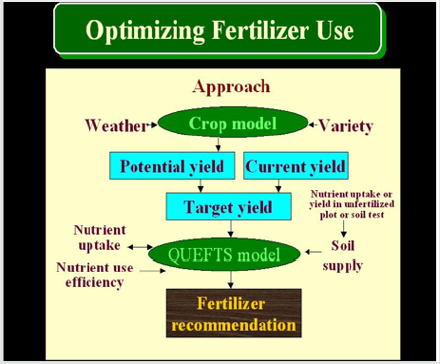
Lupine Publishers Group
Lupine Publishers
Menu
ISSN: 2637-4676
Review Article(ISSN: 2637-4676) 
Prospect of Developing Soil Health Index in Bangladesh Volume 6 - Issue 2
Sadiq MS1*, Singh IP2, Ahmad MM3, Lawal M4 and Kabeer YM1
- 1Krishi Gobeshona Foundation, BARC Complex, Bangladesh
- 2Bangladesh Rice Research Institute, Bangladesh
- 3Bangladesh Agricultural Research Institute, Bangladesh
- 4Indian Agriculture Research Institute, India
- 5Nature Inspired Computational Intelligence, (ECSE), UOIT, Canada
Received: January 23, 2019; Published: February 04, 2019
Corresponding author: Jatish C Biswas, Krishi Gobeshona Foundation, BARC Complex, Farmgate, Dhaka; Bangladesh
DOI: 10.32474/CIACR.2019.06.000234
Abstract
National economy of Bangladesh yet highly depends on agricultural development. The country has to produce foods for its everincreasing population from limited cultivable areas even from unfavorable ecosystems. Food demand has compelled the farmers to grow two to four crops in a year with and without balanced fertilizers and thus soil health has deteriorated. Soils of many parts of the country are deficient in essential macro- or micro-nutrients viz. potassium, zinc, boron, sulphur, and molybdenum. Different national research institutes have analyzed most representative soils of the country but no soil quality index (SQI) is available. The SQI needs to be developed on the basis of primary soil physical, chemical and biological attributes. These indices will help to classify soil capability to plan for sustainable agri-management strategies in terms of water and fertilizers management, adoption of appropriate tillage practices, residue and solid waste management. The development of pedo-transfer functions for characterizing soil moisture and soil nutrients characteristics are important for its subsequent use. There is also need to develop soil managers for handling problem soils in terms of crop choices and land resources management. Existing literature in Bangladesh is enough to develop SQI for subsequently relating with the resources and inputs management, crop simulation models for land use planning, inputs and resource management, yield estimates, climate change and environmental impact assessment. In the present article we have tried to link SQI for operational advisory service to the farmers for maximizing profits and also to ensure the environmental safety and sustainable soil health.
Keywords: Pedo-Transfer Functions; Decision Support System; Water and Nutrients Availability; Soil Managers; Cloud Computing; Machine Learning; Soil Information System
Introduction
Soils of Bangladesh are comparatively fertile despite of low to medium organic matter (OM) content. Major parts of Bangladesh (80%) are on Delta formed by the sedimentation. Soil Resources Development Institute (SRDI) has identified 500 soil series in Bangladesh and provides the information in terms of basic soil physical and chemical parameters; while National Agricultural Research System (NARS) and university scientist have created database on soil biology and different soil attributes. Some services like fertilizers recommendation for crops and cropping systems, optimized water management strategies, management of problem soils are being carried out, but need more precision and efficiency. Most of the recommendations are location/region specific and there is a need to develop decision platforms to provide solutions, which are relatively more spatio-temporal and independent. A total 21 general soil types have been recognized for the common users in the country (Table 1). However, there are 30 agro-ecological zones in the country that delineate crop suitability based on soil-weatherwater and land topography.
In Bangladesh, most of the farmers are small to marginal and grow more than one crop annually. At present, cropping intensity of the country is about 180%. Two to three crops are usually grown in many areas and even four crops in some regions of the country and thus nutrient mining is widespread. As soil quality refers to the capacity of a soil to function within ecosystem and land use boundaries for sustaining biological productivity, maintaining environmental quality and promoting plant and animal health [1], it should be considered as priority policy for future generations to come. Agricultural soil is also important for maintaining cleaner environment by reducing greenhouse gas emissions, preserving natural biodiversity and ensuring sustained soil-air-water-plant system.
Soil functions are not only affected by soil properties, but also influenced by climate, landscape and management and relations among these variables are complex. So, SQI has been defined in various ways [2]. Soil quality assessment typically includes the quantification of indicators that are often derived from reductionist studies or general qualitative observations of the soil [3]. So, the SQI condense enormous complexity of the soil [4] in an attempt to describe its capacity to function in soil-plant continuum. Although soil indicators were initially developed to provide information on the suitability and relative value of land for different types of agricultural production, recently it has been developed to give information on the impacts of agricultural practices on land and environmental degradation (Table 1). The prime purpose for SQI is to communicate information on possible impacts of change in land management on the outcomes of soil functions for optimal growth.
So, it is important to focus conservation practices for maintaining and improving the condition of soils and to relate soil quality to other inputs and management resources for agri-sustenance in the country. Lots of spatial and temporal based soil test-based values in terms of physical, chemical and biological attributes are available at national platform that need to be consolidated to prepare a national database and to develop pedo-transfer functions [5] for evolving soil moisture, nutrient characters, dynamics of soil biological properties, soil tilth etc. This can subsequently be employed for creating a GIS based network for linking those characters and derived parameters and henceforth linking with other socio-economic and bio-physical layers for appropriate land use plans, resource and inputs management and use in crop simulation models for initiating e-soil health services. Therefore, we have narrated our article in the following heads and sub-heads.
Problem Soils
Saline Ecosystem: About 1.0 million hectares (Mha) lands of Bangladesh are affected by varying intensities of salinity, which is even increasing because of sea level rise [6]. Crop production in this area is dominated by traditional T. Aman rice (wet season rainfed crop) varieties and farmers generally harvest 2 t ha-1 grain yield. In dry season, most areas remain fallow. Flood-prone ecosystem: It covers about 2.6 million hectares. River and flash floods are very common in Bangladesh and destroy crops, human settlements, etc depending on severity. During 1960-1986 there was only one mega flood, but five mega floods occurred during 1987-2013 indicating that frequencies of flooding are increasing in Bangladesh (BDP- 2100, 2017. The flood could be in monsoon or even in late season of Boro (dry season irrigated rice) growing period. The average yield of rice under flood-prone ecosystem is very low (2.5 t ha-1) in wet season due to lack of technologies on flood tolerance rice varieties and their appropriate fertilizer management packages, etc.
Barind-Tract: It is situated in north-west part of Bangladesh, a drier and cooler part of the country depending on seasons. Drought is very common in this part of the country having 1200-1400mm mean annual rainfall from June to October. Drought affected area is nearly 2.5 Mha in pre-monsoon and wet seasons and 1.2 Mha in dry season. In general, rice yield is poor due to lack of sufficient water and proper nutrition management. Imbalanced P:K ratio is acting antagonistically for rice crop yields in this part of the country [7].
Non-Saline Tidal Flood Ecosystem: This ecosystem covers about 1.9 Mha and the average yield of rice under non-saline tidal flood ecosystem is not more than 3 t ha-1 due to lack of technologies on appropriate fertilizer management packages, use of traditional varieties, etc. Only recently two improved rice varieties have been released by Bangladesh Rice Research Institute that can supersede grain yield of local varieties.
Haor Ecosystem: This is a wetland ecosystem in north-eastern Bangladesh covering about 80,000 square kilometers. Most of these areas remain under water for 5-7 months of the year. During dry season most of the water drains out, leaving small shallow lakes or may completely dry out by the end of dry season. This exposes rich alluvial soil and extensively used for Boro rice cultivation. However, P fixation is a problem in those areas, although not found with conventional soil testing techniques.
Soil Erosion: Water erosion is the most widespread form of degradation affecting about 10000 ha in each year in Bangladesh [8]. Accelerated soil erosion has been encountered in the hilly regions of the country, which occupy about 1.7 million hectares. About 2.5 million tons of soil is transported from hills to the foot of hills [9]. An estimated soil loss is 4.2 t ha-1 yr-1 and 7-120 t ha-1 yr-1 on 30-40% and 40-80% slopes, respectively due to shifting cultivation resulting in significant depletion of nutrients from top layer. In addition, the country is losing its forest area at the rate of about 3% annually due to deforestation. Some areas of Bangladesh are also affected by wind erosion, particularly in the Rajshahi and Dinajpur regions during dry months. The soils eroded from the hills are deposited somewhere in the downstream. Burial of agricultural land by sandy over wash is a common feature in areas adjoining the active river channels and hill streams. The entire northern and eastern piedmont alluvium and the Chittagong Hill Tracts are adversely affected by the deposition of coarse materials brought down by runoff water. Soil erosion being irreversible, is generally regarded as the most serious problem of degradation. Highly erodible soils must be protected, potentially productive soils must be conserved and eroded soils must be rehabilitated while averting their further degradation. There is a need to enhance the productivity of crops in the above-mentioned problem and degraded soils. We need to identify proper land use types and inputs and resource management options to maximize the productivity by also safeguarding the environments. We need to develop excelbased soil managers for addressing suitable options for sustenance and these types of decision support system (DSS) should be on-line for effective agro-advisory services for the farmers.
Approaches for SQI Development
There are numerous procedures to evaluate soil quality (Figure 1), keeping in mind that most of them being location specific; but the approach suggested can be followed, improved and calibrated for the test environments. The SQI could be visual, sensory, physical, chemical or biological and combinations of some of them. The attributes to be used for developing SQI depends upon its use in specific management; for example, water and nutrients management. Soil quality assessments often rely on indicators from several of these categories, and one of the challenges is how to integrate them together. Some of the parameters as discussed below can be considered for SQI determination. Visual indicators may be obtained from observation or photographic interpretation, which can be a clear indicator that soil quality is threatened or changing. Exposure of subsoil change in soil color, ephemeral guidelines, ponding, runoff, plant response, weed species, blowing soil, and deposition of residues, and industrial effluents/solid wastes can also be considered as indicators (Figure 1).
Physical Indicators: Physical indicators reflect the texture, stability and arrangement of the soil particles and pore size distribution. These properties directly influence water relations, gas exchange, resistance to degradation, and root growth. Often physical indicators, such as infiltration rate, aggregate stability and hydraulic conductivity are used to integrate properties. It is recommended that dispersion ratio is accepted as an indicator for describing soil physical quality and for soil aggregate stability. It can be considered as a sensitive indicator for long-term change depending on relative ability to resist rapid temporal changes. A measure of aggregate stability would also offer a better assessment of soil physical quality in stony soils. Attributes for assessing soil physical health are particle size distribution, soil organic carbon (SOC), bulk density, aggregate stability, penetration resistance, infiltration rate, saturated/unsaturated hydraulic conductivity, pore size distribution, and moisture retention characteristics. Pedo-transfer functions have been reported in literature for characterizing soil moisture retention, release and transmission characteristics derived on the basis of easily determinable soil parameters, such as soil texture and SOC [10-12]. These functions have been commonly employed in globally accepted crop models such as DSSAT, INFOCROP, WOFOST and APSIM. Components of soil water balance are simulated by the use of soil moisture retention and its release and transmission characters, atmospheric demand, root zone depth and actual soil water availability. There is a need to understand the dynamics of soil physical conditions under zero and minimum tillage on short- and long-term basis, and the models to cover these aspects are limited. Some of the models describe soil mechanical impedance from soil texture, organic carbon and land management, which can be effectively used for tillage management and understanding root growth in terms of depth and distribution.
Chemical Indicators: Most of us are familiar with nutrients availability and their ratios, antagonistic and synergistic effects, SOC content, pH, EC and CEC. The SQI could be developed by assessing nutrients availability and henceforth can be utilized for fertilizer recommendation, for designing customized fertilizers (CF), and for handling of saline, sodic, and acid soils, etc. Lots of works have been done in the country, and successful operational implementation have been demonstrated on specific regional scales, but there is a need to design a DSS for operational services for soil management by the farmers in contrasting growing regions under natural and manmade pressures.
Soil Managers
Different types of soil manages can be developed (Table 2) depending on available attributes and the knowledge or perception of end users. These functions and modules are developed on the basis of simple Excel based macros, with use of technical coefficient generators, experts’ judgment and thumb rules. These services need to be operational for effective agri-knowledge dissemination to the farmers, agri-clinics and policy planners. Under present era of rapid industrial growth, there is a need for safe disposal and/or utilization of solid wastes as nutrients for agricultural production and as soil conditioners. Such efforts are energy efficient and nature conserving. We need to design the conjunctive use of effluents with good quality waters for sustenance as well provision of nutrients from spent wash/effluents by ensuring safeguard from trace/ heavy/toxic elements. There is a need to develop soil managers for handling problem soils as well for fertilizers recommendation in various growing regions. Site specific nutrient management (SSNM) based on soil N, P and K availability, problem soil viz. pH and EC and crops and cropping system choice, fertilizers inputs judged on fertilizers recovery, nutrients uptake efficiencies and on the basis of target yield of crops and cropping systems need to be developed. This approach is commonly followed at research and extension agencies. In Bangladesh, problem soils in terms of soil reaction and waterlogging conditions are common, so fertilizer management plays a key role in maximizing yields of the crops as well safeguarding the soil health on sustainable basis (Table 2).
One has to understand the multi-nutrients interaction for optimization of fertilizers for maximizing crops/cropping systems yields. For example, CF (all in one) has been designed at Tata Chemicals Limited, India and subsequently followed by other fertilizer industries and to provide region/target yield based CFs having ingredients of all needed fertilizers (with around 20% of N-input) in one particle, manufactured through process of steam granulation. Excel based model was developed to compute the nutrients requirements, and the particle was prepared and tested through multi-location trials at the farmers’ fields over the locations. There was significant yield increase in farmers’ fields. Nutrients uptake efficiency was increased significantly through adoption of CF and also resulting in higher cost-benefits ratio. The scope of foliar nutrients application, fortified with organic and inorganic sources, bio-fertilizers, sea-weeds is avenue for crop improvement and these components need to include along with basal inorganic fertilizer uses. Fertilizers recommendation, as advocated through public sector, have to evolve a scientific and quantitative approach through the use of optimization models and decision tools for effective knowledge dissemination and products delivery to the farmers. Under present context of intensive agriculture and reduced partial factor productivity, mainly for nutrients, there is a requirement to introduce the products viz. CF for basal and foliar application, fortified organic and inorganic nutrient sources, use of sea-weeds and plant growth promoters in the market, for which a well designed research is needed to be started in this region of the world.
Tata Chemicals Limited (TCL), India developed CFs, a complete balanced doze of appropriate nutrients needs specific to a crop and the target yield. If the fertilizer particles, different in size and function, are applied physically may result in reduced nutrients uptake efficiency. In particular uptake efficiency of micro-nutrients would be very low. The CFs (crop specific) were developed commercially based on soil test crop response (STCR) and following the approach of steam granulation and anticipating the enhanced efficiency of basic nutrients’ inputs, the doze of combo-inputs in appropriate proportion and also understanding the antagonistic inter-nutrients interaction were decided based on large number of on-farm trials with test crops such as wheat, rice, maize, sugarcane, and menthe. The CF products were effective in terms of higher cost-benefit ratio, increased nutrients uptake efficiency, and environment friendly. There is a need to bring CF basal and foliar products through public-private interaction for enhancing the agricultural production and keeping environment safety in mind. Indian Institute of Soil Science, Bhopal, Madhya Pradesh, India has been involved in conducting all India coordinated trials on STCR following the principles of SSNM for deciding the fertilizers doze for specific crops and cropping systems. As an example, Figure 2 shows the STCR based approach followed by TCL in developing CFs. Bangladesh should develop fertilizer particles as basal and foliar products, although coordinated trials based on STCR have been done at numerous research stations in Bangladesh.
Figure 2: Quantitative approach followed by TCL, India in bringing CFs for growing wheat, rice, potato, sugarcane, maize and menthe.
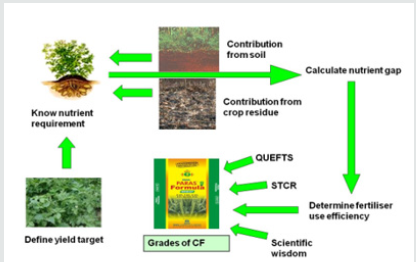
In case of several chemical indicators, the role of soil pH on nutrient availability is crucial (Figure 3). The measurement of soil pH has been undertaken in many national and state soil surveys to define suitability of soil [3]. As a use-dependent soil quality indicator, it has shown a practical way to address the management options for agri-sustenance [13]. The use of pH as an indicator for the soil function of environmental interaction is due to its explicit relevance to soil biological activity, potential metal toxicity and water quality, nutrient behavior and flora and fauna species diversity. There is a strong need to develop soil manager- soil reaction based to manage problem soils for optimization of agricultural production with appropriate resource and inputs management options. The concept of resource conservation technologies (RCTs) is getting importance for sustainable agriculture and for safeguarding the environment. Zero/minimum tillage, suitable and well-designed water and nutrients management practices, crops/cropping systems choice, use of green agricultural products, appropriate agronomic management practices, and the model for intensive/extensive agriculture are needed to be considered in designing appropriate RCTs for this important region of intensive agriculture, where we have to feed a large population of the sub-continent.
Biological Indicators
Soil microbial activity is an indicator of soil fertility, mainly SOC is the basic index of soil nutrients availability and directly/indirectly controlled by mineralization and immobilization. Soil microbial C and soil microbial N are commonly employed for relating with the growth of crops and cropping systems, but these attributes are highly spatio-temporal variant as well as difficult to determine. Pedo-transfer functions are being derived to compute the basic soil biological parameters from easily determinable soil properties, which need to be involved for Bangladesh. The development of soil biological indicator (SBI) is a bit cumbersome and the attributes for its monitoring are highly spatio-temporally dynamic and with high variability. Some of the parameters, commonly used in literature, need to be used in appropriate way/procedure to define precisely soil fertility through availability, mineralization and/ or immobilization. A generalized flow of OM decomposition and nutrient availability is shown in Figure 4, which can be considered for testing soil quality. Many indirect tests are also used for microbial status such as respiration, enzyme activities and functions such as nitrogen (N) mineralization and OM decomposition. In general, root health, beneficial microbes, OM content, active carbon, potential mineralizable N, etc [14] are needed for determination of SBI.
A healthy soil will have a high and diverse population of beneficial organisms to perform different functions in soils. Among microbes, bacteria help in OM decomposition and some of them fix atmospheric N2. Actinomycetes degrade larger lignin molecules of organic residues and they are responsible for earthy smell. Fungi help in decomposing crop residues, especially hemicellulose and lignin. Protozoa are instrumental in mineralizing N in agricultural systems. Large macroscopic organisms such as earthworms, insects and millipedes are important for improving aggregation, soil drainage, and aeration due to their burrowing/channeling nature. A poor soil may have 0-1 earthworm in a shovelful top soil, no casts or holes, no visible crop residues and no color variation between top and sub-soils. On the other hand, a good soil will retain more than 10 earthworms in top foot soil having lots of casts and holes and birds run behind tillage operations, top soil is darker than subsoil, presence of noticeable roots and crop residues [14]. A good soil has also residues of variable degradation stages and a fresh earthy smell [15].
As SBI reflect soil fertility, indices like microbial C or microbial N become the indicator of mineral N availability, although total N or available N may be crude to estimate the uptake by the plants. There is a need to relate total or available-N with microbial-N to compute uptake of N by the plants. Most of the crop models are based on crude computation procedure for N uptake by the plants, but through process of calibration we try to come near to the actual values. Soil biological health through well defined indicator, deduced from easily determinable soil parameter is the need of the hour. Figure 4 shows the transformation dynamics of organic manures application for enhanced availability and hence uptake of N, P and K; but there is a need to derive the availability through computational microbial processes, which has been dealt in empirical way, but we have to develop mechanistic module for this purpose.
The concept of soil information system is talked by researcher, which should have spatio-temporal information on physical, chemical and biological characters; the information system should have transfer functions and technical coefficients for soil moisture retention and release characters, soil nutrients availability, soil biological health and problem soils in terms of waterlogging and soil reaction. Information system should also have DSS for aid in water, tillage and nutrient managements. It should have the features of big data bases, machine learning and artificial intelligence (AI) for managing soils for optimized agricultural production and safeguarding the environment [16]. Fertilizers recommendation, in terms of N, P and K dose for specific crop and target yield approach, based on soil nutrients availability and fertilizers recovery efficiency is done through use of QUEFTS model. [23] tested QUEFTS model in the farmers’ field for wheat as a test crop successfully employed optimized N, P and K application with maximized wheat yield and also saving fertilizers inputs as well enhancing the nutrients uptake efficiency (Figure 5). QUEFTS model is versatile, however there is a need to include secondary and micro-nutrients by also considering inter-nutrients interaction for deciding the inputs and maximization of the yield.
Steps of SQIs Development
Some steps for the development of SQIs could be farmers’ perception, formulation of appropriate goals/outcomes, identification of suitable and easily determinable soil attributes and collation of database for these attributes and finally deriving their inter-relationships for specific processes through pedotransfer functions development and calibration/validation. Most of the approaches for SQI development include the scoring function criteria, along with the choice of attributes for a specific application, but the weightage to each attribute score needs to be worked out, which has to be accomplished very carefully.
The New Zealand group [17], from an initial list of over 20 attributes, selected total carbon, total N, pH, Olsen P, mineralizable N, bulk density and macro- and total- porosity as indicators. Information on the following aspects was described:
a) A brief background, including how SQI will relate with various soil functions in relation to eco-system interaction;
b) Quantification of changes in soil environment, through SQIs and selection of cardinal values for precisely defining the state
c) Integration with other national monitoring schemes for effective knowledge dissemination;
d) Cost effectiveness and well defined process to be undertaken for implementation.
The optimum time and location for observing or sampling SQIs usually depends on the functions for which the assessment is being made. Soil variation across a field, forest or pasture can greatly affect the choice of indicators. Soil functions depends on both stable and dynamic soil properties, and the decision to limit assessment to either stable or dynamic soil properties is primarily a product of objectives. For example, an objective to compare potential crop productivity or attainable yields at different locations will primarily focus on stable soil properties (e.g., topsoil depth, pH, texture), whereas actual yields could be predicted from dynamic soil attributes like soil water or nutrients availability, which would be needed to be monitored much more intensively. Indicators cannot be developed without a clear context and purpose, in terms of the information to be transferred and the types of target users [18]. End users must be involved to ensure that selected indicators are effective in communicating the relevant messages. Databases consisting of observed outcomes and the variables controlling outcomes should be assembled. Possible sources of data include benchmark studies, long-term crop rotation studies, research trials, and outputs from reliable models. Candidate indicators for outcomes of each soil function can be obtained from previous studies or derived from appropriate models. Three basic questions must be addressed when testing candidate indicators [19] for suitability and effectiveness of the functions.
Indicators for different goals should only be aggregated after they have been validated for individual goals. Aggregation first requires an assessment of the relations amongst goals. Aggregation also requires an assessment of the relative value of the different goals. Different end users may have highly divergent viewpoints on the importance of different goals, thereby making aggregation of divergent goals a bit difficult. We have to consider that most people cannot make direct use of a quantitative SQI as illustrated above for their own measurements [21, 22], although many studies have been conducted to provide quantitative soil quality comparisons for various systems, soils and locations. These results can be useful for growers of the country in evaluating their own situations and choosing their own indicators to track over time. Besides, some important services can be provided based on soil health quality as stated below:
Based on various machine learning classifiers (viz. Eureqa, Linear Regression, Logistic Regression, Naïve Bayes (Gaussian), k-Nearest Neighbor, Decision Tree, Support Vector Machine) can be effectively used in design of SQI, methodology development for soil rating by integrating physical, chemical and biological features. The SQI and soil rating could be employed for various applications in water/nutrients/tillage management options. There is a need to integrate technical coefficient and experts’ judgment for developing soil managers/sub-modules which can be used in various steps of classification for appropriate decision making. We are beginning in the field of machine learning and AI for Soil Management and Crops Productivity Assessment, where the crop and soil process models can also be integrated. Weka 3.8.2, a simple machine learning tool, having wide variety of classifiers, easy to operate can be effective for beginners to start work on soil health assessment, agricultural productivity assessment and insects/pests forecasting [23, 24]. Agriculture shows great scope of machine learning applications, by also using crop simulation and optimization tools. Huge databases normally available attract us toward cloud computing, decision tools, internet of things for effective operational agricultural applications.
Some Examples for SQI to be Used in Machine Learning and Simulation Techniques
a) SQI development- Eureqa-1-24-0, Logistic Regression, k-Nearest Neighbor, Linear Regression
b) Soil Moisture Characteristics (retention/release/ transmission)- Eureqa, Linear Regression, Logistic Regression, Naïve Bayes, k-Nearest Neighbor
c) Water and Nutrients Production Functions, Eureqa, Linear Regression, Logistic Regression, Decision Tree, Statistical Tools, Optimization tools for irrigation scheduling, Multi-nutrients interaction with statistical tools and machine learning classifiers
d) Soil Productivity Rating (relating with crop yield delineation) (on the basis of SQI), k- Nearest Neighbor, Linear Regression, Eureqa, satellite image/unsupervised and supervised classification, soil managers and simple developed macros
e) Problem soil management, Eureqa, Linear and Logistic Classifiers, Naïve Bayes, decision tree, soil managers and simple developed macros
f) Fertilizers Recommendations, QUEFTS, STCR, Eureqa, Linear/Logistic Classifiers, k-Nearest Neighbor
Soil Health Services: A Few Examples
a) Soil health services can be accomplished in different ways, for example
b) Nutrient management on the basis of soil nutrients soil, pH, EC, nature of crop, soil texture, bulk density, root penetration ability, tillage and residue management options and weather,
c) Water management based on nature of crop, soil texture, bulk density, root penetration ability, soil available water, nutrient inputs and weather
d) Tillage need based on crop type, bulk density, soil mechanical impedance, extent of waterlogging, surface roughness and moisture conditions
e) Insect pest and diseases extent and control option on the basis of crop type, soil moisture and irrigation scheduling, rainfall pattern, humidity, temperature and nutrients input.
Conclusion
The SQI development is important for which there is a need to use selected physical, chemical and biological parameters. These indices can help in deciding appropriate land management and resource and inputs management options for enhancing the yields of crops and cropping systems. The SQI developed should have strong calibration and validation for testing in the farmers’ fields and operational areas. Most of the SQIs developed lack in testing and operational applications, although the approach is based on strong basic approach. The SQIs developed have to be dealt on the basis of selected attributes based on the type of application such as in water, in soil and with tillage operations, etc. Numerous soil test values are reported in literature but have not being to a platform of cloud computing, machine learning, AI to strengthen the operational application of soil information system for taking to applications in case of water, fertilizer management and suggesting options for appropriate resource conservation technologies for sustainable agriculture. We should have DSS for land management and suggesting inputs and resources management for optimized agricultural production by safeguarding the environment. Bangladesh has numerous soil types, production environments and problem soils to handle; we should have decision tools for strong land management principles. However, numerous research works have been done in the past in contrasting regions, and we have to consolidate the results and develop transfer functions and prepare DSS for suggesting appropriate land management options. The concept of soil managers on operational basis needs to be built in.
References
- Doran JW, TB Parkin (1994) Defining and assessing soil quality. In: JW. Doran et al. (Ed.) Defining soil quality for a sustainable environment. SSSA Spec Pub 35 SSSA Madison WI, p. 3-21.
- Karlen DL, MJ Mausbach, JW Doran, RG Cline, RF Harris, GE Schuman (1997) Soil quality: a concept, definition, and framework for evaluation. Soil Science Society of America Journal 61: 4-10.
- Seybold CA, Mausbach MJ, Karlenand DJ, Rogers HH (2003) Quantification of soil quality. In: Lal R, Kimble JM, Follet RF, Stewart BA. (eds.). Advances in Soil Science CRC Press. Boca Raton. Florida, USA, pp. 387-404.
- Schjonning P, S Elmholt, BT Christensen (2004) Soil quality management. Concepts and terms. In: P Schjonning, S Elmholt, BT Christensen (eds.). Challenges in modern agriculture. CAB Intl, pp. 1-15.
- Adhikary PP, D Chakraborty, N Kalra, CB Sachdev, AK Patra, et al. (2008) Pedo-transfer functions for predicting the hydraulic properties of Indian Soils. Aust J Soil Res 46(5): 476-484.
- SRDI (Soil Resources Development Institute) (2010) Saline Soils of Bangladesh. SRMAF Project, Ministry of Agriculture. pp. 55.
- Biswas JC, MM Haque, PK Saha (2017) Rice yield potential under unfavorable ecosystems in Bangladesh. Asian J Soil Sci Plant Nutr 1(4): 1-10.
- GOB (Government of Bangladesh) (2010) National Disaster Management Plan 2010-2015. Dhaka: Disaster Management Bureau.
- Hossain MA (2011) An overview of shifting cultivation with reference to Bangladesh. Scientific Res Essays 6(31): 6509-6514.
- Rai HK, S Anil, J Sindhu, DK Das, N Kalra (2003) Pedo-transfer functions for assessing soil moisture and nitrogen availability in the Indian soils. SAARC J Agric (1): 127-140.
- Kalra N, PK Aggarwal, SK Bandyopadhyay, AK Malik, S Kumar (1994) Prediction of moisture retention and transmission characteristics from soil texture of Indian soils. In: (Eds. F.P. Lansigan, Bouman, B.A.M. and Laar, H.H. van). Agro-ecological Zonation, Characterization and Optimization of Rice Based Cropping Systems. SARP Research Proceedings, AB-DLO and TPE, Wageningen, p. 26-35.
- Chakraborty D, A Chakraborty, P Santra, RK Tomar, RN Garg, et al. (2006) Prediction of hydraulic conductivity of soils from particle size distribution. Current Sci 90 (11): 1526-1531.
- Smith JL, Doran JW (1996) Measurement and use of pH and electrical conductivity of soil quality analysis, pages 169-185 in: JW Doran and AJ Jones (eds) Methods for Assessing Soil Quality, SSSA Spec Publ, SSA, Madison, WI.
- Gumino BK, Idowu OJ, Schindelbeck RR, van Es HM, Wolfe DW, et al. (2009) Cornell Soil Health Assessment Training Manual. Second Edition. Cornell Digital Print Services, Ithaca, NY, USA, pp. 57.
- Sundermeier A (2018) Ohio Soil Health Card, Sustainable Agriculture Fact Sheet Series, Ohio State University, USA.
- Anand P, H Bansal, S Kansal, R Goel, O Ahmed, et al. (2004) Soil information system: Evaluating soil moisture and fertility indices for land capability classification. Bioinformatics India 2(3): 35-37.
- Sparling G, L Lilburne, M Vojvodić Vuković (2003) Provisional targets for soil quality indicators in New Zealand. Land Care Res Sci Series No. 34; Lincoln, Canterbury, New Zealand.
- Crabtree JR, FM Brouwer (1999) Discussion and conclusions. Pages 279 - 285 in JR Crabtree and FM Brouwer, eds. Environmental indicators and agricultural policy. CABI publishing, New York, USA.
- Bockstaller C, P Girardin (2003) How to validate environmental indicators. Agril Sys 76(2): 639-653.
- BDP (Bangladesh Delta Plan 2100) (2017) Bangladesh Delta Plan 2100. Government of the People’s Republic of Bangladesh, Bangladesh Planning Commission, General Economics Division, p. 13.
- FAO (Food and Agriculture Organization) (1988) Land resources appraisal of Bangladesh for agricultural development. Rome, Italy.
- FRG (Fertilizer Recommendation Guide) (2012) Bangladesh Agricultural Research Council, Farmgate, Dhaka, Bangladesh.
- Pathak H, PK Aggarwal, R Roetter, N Kalra, SK Bandyopadhaya, et al. (2003) Modelling the quantitative evaluation of soil nutrient supply, nutrient use efficiency and fertilizer requirements of wheat in India. Nutrient Cyc Agro-ecosys 65(2): 105-113.
- Windish B (2017) Soil pH and lime: How lime affects your soil.

Top Editors
-

Mark E Smith
Bio chemistry
University of Texas Medical Branch, USA -

Lawrence A Presley
Department of Criminal Justice
Liberty University, USA -

Thomas W Miller
Department of Psychiatry
University of Kentucky, USA -

Gjumrakch Aliev
Department of Medicine
Gally International Biomedical Research & Consulting LLC, USA -

Christopher Bryant
Department of Urbanisation and Agricultural
Montreal university, USA -

Robert William Frare
Oral & Maxillofacial Pathology
New York University, USA -

Rudolph Modesto Navari
Gastroenterology and Hepatology
University of Alabama, UK -

Andrew Hague
Department of Medicine
Universities of Bradford, UK -

George Gregory Buttigieg
Maltese College of Obstetrics and Gynaecology, Europe -

Chen-Hsiung Yeh
Oncology
Circulogene Theranostics, England -
.png)
Emilio Bucio-Carrillo
Radiation Chemistry
National University of Mexico, USA -
.jpg)
Casey J Grenier
Analytical Chemistry
Wentworth Institute of Technology, USA -
Hany Atalah
Minimally Invasive Surgery
Mercer University school of Medicine, USA -

Abu-Hussein Muhamad
Pediatric Dentistry
University of Athens , Greece

The annual scholar awards from Lupine Publishers honor a selected number Read More...




